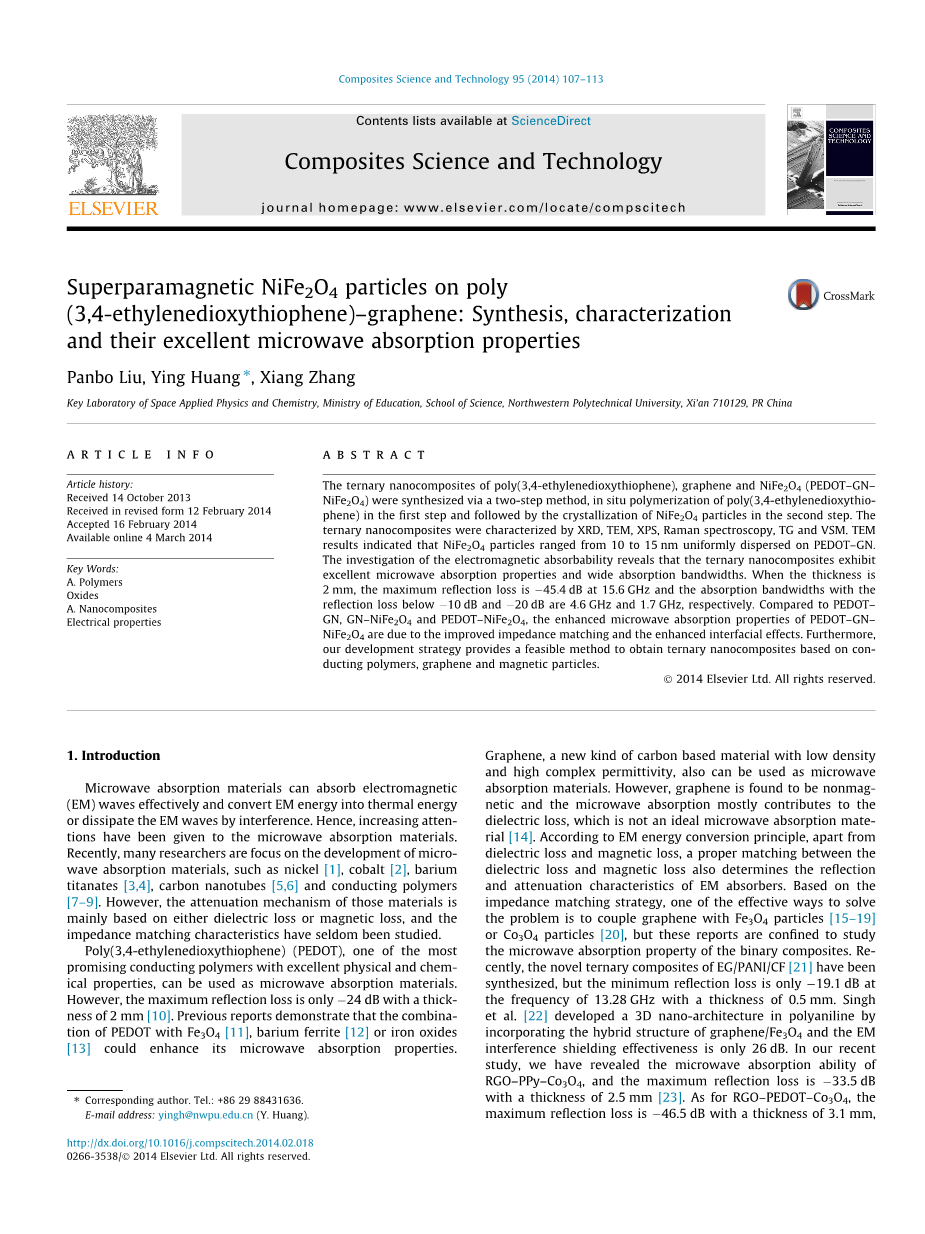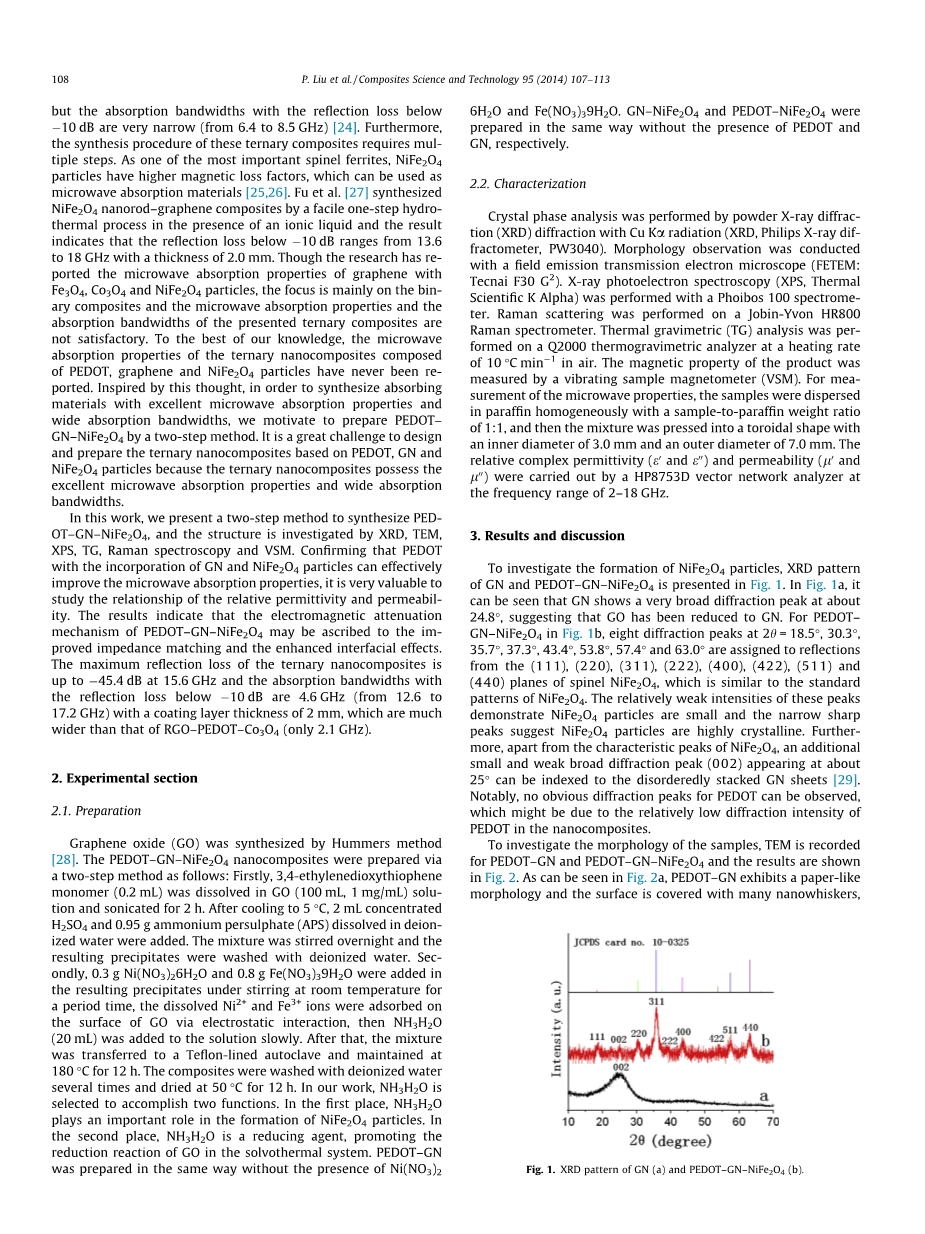

英语原文共 7 页,剩余内容已隐藏,支付完成后下载完整资料
Superparamagnetic NiFe2O4 particles on poly
(3,4-ethylenedioxythiophene)–graphene: Synthesis, characterization
and their excellent microwave absorption properties
聚电解质上的超顺磁性NiFe2O4粒子(3,4-亚乙基二氧基噻吩)-石墨烯:合成、表征及其优良的微波吸收性能
ABSTRACT: The ternary nanocomposites of poly(3,4-ethylenedioxythiophene), graphene and NiFe2O4 (PEDOT–GN–NiFe2O4) were synthesized via a two-step method, in situ polymerization of poly(3,4-ethylenedioxythiophene) in the first step and followed by the crystallization of NiFe2O4 particles in the second step. The
ternary nanocomposites were characterized by XRD, TEM, XPS, Raman spectroscopy, TG and VSM. TEM results indicated that NiFe2O4 particles ranged from 10 to 15 nm uniformly dispersed on PEDOT–GN. The investigation of the electromagnetic absorbability reveals that the ternary nanocomposites exhibit excellent microwave absorption properties and wide absorption bandwidths. When the thickness is 2 mm, the maximum reflection loss is 45.4 dB at 15.6 GHz and the absorption bandwidths with the reflection loss below 10 dB and 20 dB are 4.6 GHz and 1.7 GHz, respectively. Compared to PEDOT–GN, GN–NiFe2O4 and PEDOT–NiFe2O4, the enhanced microwave absorption properties of PEDOT–GN–NiFe2O4 are due to the improved impedance matching and the enhanced interfacial effects. Furthermore,
our development strategy provides a feasible method to obtain ternary nanocomposites based on conducting polymers, graphene and magnetic particles.
摘要:聚( 3,4 -亚乙基二氧噻吩)、石墨烯和NiFe2O4的三元纳米复合材料( PEDOT–GN–NiFe2O4 )是通过两步法合成的。第一步是聚( 3,4 -亚乙基二氧噻吩)的原位聚合,第二步是NiFe2O4颗粒结晶。采用XRD、TEM、XPS、拉曼光谱、TG和VSM对三元纳米复合材料进行了表征。通过透射电镜得出,NiFe2O4颗粒在PEDOT - GN上均匀分散在10 - 15 nm范围内。电磁吸收性的研究表明,三元纳米复合材料表现出优异的微波吸收性能和宽的吸收带宽。当吸收带宽为15.6 GHz时,最大反射损耗为-45.4 dB,吸收带宽为4.6 GHz和1.7 GHz的反射损耗分别为-10 dB和-20 dB以下。与PEDOT - GN,GN - NiFe2O4和PEDOT - NiFe2O4相比,PEDOT - GN - NiFe2O4微波吸收特性的增强,是由于改进的阻抗匹配和增强的界面效应。此外,我们的发展战略为获得基于导电聚合物、石墨烯和磁性粒子的三元纳米复合材料提供了一种可行的方法。
Key Words : Polymers Oxides, Nanocomposites Electrical properties
关键词:聚合物氧化物;纳米复合材料的电气性能
- Introduction
Microwave absorption materials can absorb electromagnetic(EM) waves effectively and convert EM energy into thermal energy or dissipate the EM waves by interference. Hence, increasing attentions have been given to the microwave absorption materials. Recently, many researchers are focus on the development of microwave absorption materials, such as nickel [1], cobalt [2], barium titanates [3,4], carbon nanotubes [5,6] and conducting polymers [7–9]. However, the attenuation mechanism of those materials is mainly based on either dielectric loss or magnetic loss, and the impedance matching characteristics have seldom been studied. Poly(3,4-ethylenedioxythiophene) (PEDOT), one of the most promising conducting polymers with excellent physical and chemical properties, can be used as microwave absorption materials. However, the maximum reflection loss is only 24 dB with a thickness of 2 mm[10]. Previous reports demonstrate that the combination of PEDOT with Fe3O4 [11], barium ferrite [12] or iron oxides [13] could enhance its microwave absorption properties. Graphene, a new kind of carbon based material with low density and high complex permittivity, also can be used as microwave absorption materials. However, graphene is found to be nonmagnetic and the microwave absorption mostly contributes to the dielectric loss, which is not an ideal microwave absorption material[14]. According to EM energy conversion principle, apart from dielectric loss and magnetic loss, a proper matching between the dielectric loss and magnetic loss also determines the reflection and attenuation characteristics of EM absorbers. Based on the impedance matching strategy, one of the effective ways to solve the problem is to couple graphene with Fe3O4 particles [15–19] or Co3O4 particles [20], but these reports are confined to study the microwave absorption property of the binary composites. Recently, the novel ternary composites of EG/PANI/CF [21] have been synthesized, but the minimum reflection loss is only 19.1 dB at the frequency of 13.28 GHz with a thickness of 0.5 mm. Singh et al. [22] developed a 3D nano-architecture in polyaniline by incorporating the hybrid structure of graphene/Fe3O4 and the EM interference shielding effectiveness is only 26 dB. In our recent study, we have revealed the microwave absorption ability of RGO–PPy–Co3O4, and the maximum reflection loss is -33.5 dB with a thickness of 2.5 mm [23]. As for RGO–PEDOT–Co3O4, the maximum reflection loss is -46.5 dB with a thickness of 3.1 mm,but the absorption bandwidths with the reflection loss below -10 dB are very narrow (from 6.4 to 8.5 GHz) [24]. Furthermore, the synthesis procedure of these ternary composites requires multiple steps. As one of the most important spinel ferrites, NiFe2O4 particles have higher magnetic loss factors, which can be used as microwave absorption materials [25,26]. Fu et al. [27] synthesized NiFe2O4 nanorod–graphene composites by a facile one-step hydrothermal process in the presence of an ionic liquid and the result indicates that the reflection loss below -10 dB ranges from 13.6 to 18 GHz with a thickness of 2.0 mm. Though the research has reported the microwave absorption properties of graphene with Fe3O4, Co3O4 and NiFe2O4 particles, the focus is mainly on the binary composites and the microwave absorption properties and the absorption bandwidths of the presented ternary composites are not satisfactory. To the best of our knowledge, the microwave absorption properties of the ternary nanocomposites composed of PEDOT, graphene
全文共32502字,剩余内容已隐藏,支付完成后下载完整资料
资料编号:[2566]
您可能感兴趣的文章
- BaTiO3和SrTiO3纳米立方单晶体的有 序组装的压阻响应特性外文翻译资料
- 结构对有机硅改性酚醛树脂热稳定性及抗氧化机理的影响外文翻译资料
- 磷酸三(2-巯基乙基)固化环氧热固树脂的高折射率和阻燃性外文翻译资料
- 燃烧合成TiB2-Cu金属陶瓷的抗烧蚀性外文翻译资料
- 氢键在光诱导水离解中的作用:一把双刃剑外文翻译资料
- 碳酸氢钠/偶氮二异丁腈协同作用对低密度不饱和聚酯树脂制备的影响外文翻译资料
- 利用钢渣和草酸氢钾制备新型化学键合陶瓷外文翻译资料
- A位空位型钛酸铋钠基弛豫铁电体 具有超高的能量密度和更高的放电效率外文翻译资料
- 用热分析方法测定含氯化钠和氯化钾的油 井水泥浆体的水化产物外文翻译资料
- 将垂直排列的石墨烯片多孔膜用于高效太阳能热净水外文翻译资料


